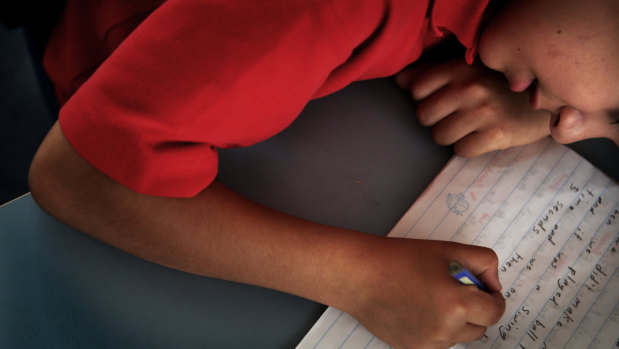By Jordan Baker
NSW students have been hit worse than expected by online learning during COVID-19, with tests showing they have fallen three to four months behind in key areas such as reading and numeracy.
Students did not sit NAPLAN tests in May due to the coronavirus, but similar assessments provided to NSW Department of Education schools in the second half of the year found the average reading score for year 3 students in 2020 was up to four months behind last year's cohort.

Students fell months behind in reading and numeracy due to remote learning Credit: Louise Kennerley
Year 5 was two to three months behind in reading and numeracy, while year nine was two to three months behind in numeracy, a department report found. The results come as the NSW government begins recruiting tutors as part of a $377 million program to help students catch up.
NSW is the first jurisdiction in Australia to measure the educational impact of remote learning.
Education Minister Sarah Mitchell said students did make progress during online learning, but not at their usual pace. "Knowing where students are up to allows us to help them in the areas of their education where it is needed most," she said.
Julie Sonnemann, a fellow in school education at the Grattan Institute whose modelling predicted the gap between advantaged and disadvantaged students would grow by seven per cent, described the results as a "bigger drop than expected".
"If that's the average then I would be concerned about the progress of the most disadvantaged students, who are likely to have struggled most," she said.
Glenn Fahey from the Centre for Independent Studies, who predicted in May that disadvantaged students would lose two weeks' of learning in maths and more than a week in reading, said addressing the problem must be a priority.
"This learning loss is simply staggering – certainly beyond the expectations of most observers," he said.
The NSW Department of Education compared a weighted mean score from the check-in assessments, which were held between August and October this year, with the average of the 2019 NAPLAN tests, which were held in May.
On most indicators the average marks were almost the same, suggesting this year's cohort was at a similar point in their learning in term three as last year's was three to four months earlier, in May. The exception was year 3 numeracy, where progress was strong.
"On average students have fallen approximately three to four months behind in year 3 reading, and two to three months behind in year 5 reading and numeracy and year 9 numeracy," the report found. Year 9 reading was not linked with the NAPLAN scale.
Dr Sonnemann supported tutoring as an evidence-based way to help students catch up. She said the results suggested schooling was disrupted not only during the remote learning period, but in the weeks before and after it due to student, parent and teacher stress.
However, Mr Fahey said tutoring was not a cost-effective solution.
"Given the seriousness of educational damage, offering up summer schooling to the most impacted students is a no-brainer," he said. "That won't be popular with teachers and parents. But we simply can't ignore lagging student progress and dismiss it as next year's problem."
Dr Sonnemann and Mr Fahey said the results would be closely scrutinised by Victoria, where students were taught remotely for much longer due to a second wave of COVID-19.
Unlike NAPLAN, which is mandatory for students in years 3, 5, 7 and 9 each year, the NSW check-in assessments were optional. NAPLAN results take months, but check-in data was available within 48 hours. Check-in results will not be provided to parents.
The tests involved 40 multiple choice questions over about 50 minutes, although teachers could use their discretion. Year 5 and 9 sat them between mid-August and early September, and year 3 between late September and October.
NAPLAN items were included to allow comparison with last year's test. Due to the success of the assessments for years 3, 5 and 9, the department will now provide them for other year groups.
Craig Petersen, head of the Secondary Principals Council, said schools found the information and quick turnaround useful. "The data is telling us that students haven't fallen behind, but during the learning from home period they have not progressed as far as they would have," he said.
Anecdotally, principals and teachers found those who struggled most with remote learning were the students who struggled most before COVID-19. "The most disadvantaged students were going to be the most disadvantaged – low [socio-economic, those with a disability, indigenous students," he said.
Robyn Evans, from the Primary Principals Association, said the tests generated less pressure than NAPLAN. "None of our kids were fatigued or stressed," she said.
"It was really important for us to capture where the kids were, so when we step into the support the department has offered, we'll be able to pick up where the kids need to be."
Ms Mitchell said retired and temporary teachers could begin applying for tutoring jobs through Teach NSW. More than 8000 people had already expressed interest in the 12-month scheme, which will provide an average of 1700 tutoring hours per school.
Start your day informed
Our Morning Edition newsletter is a curated guide to the most important and interesting stories, analysis and insights. Sign up here.